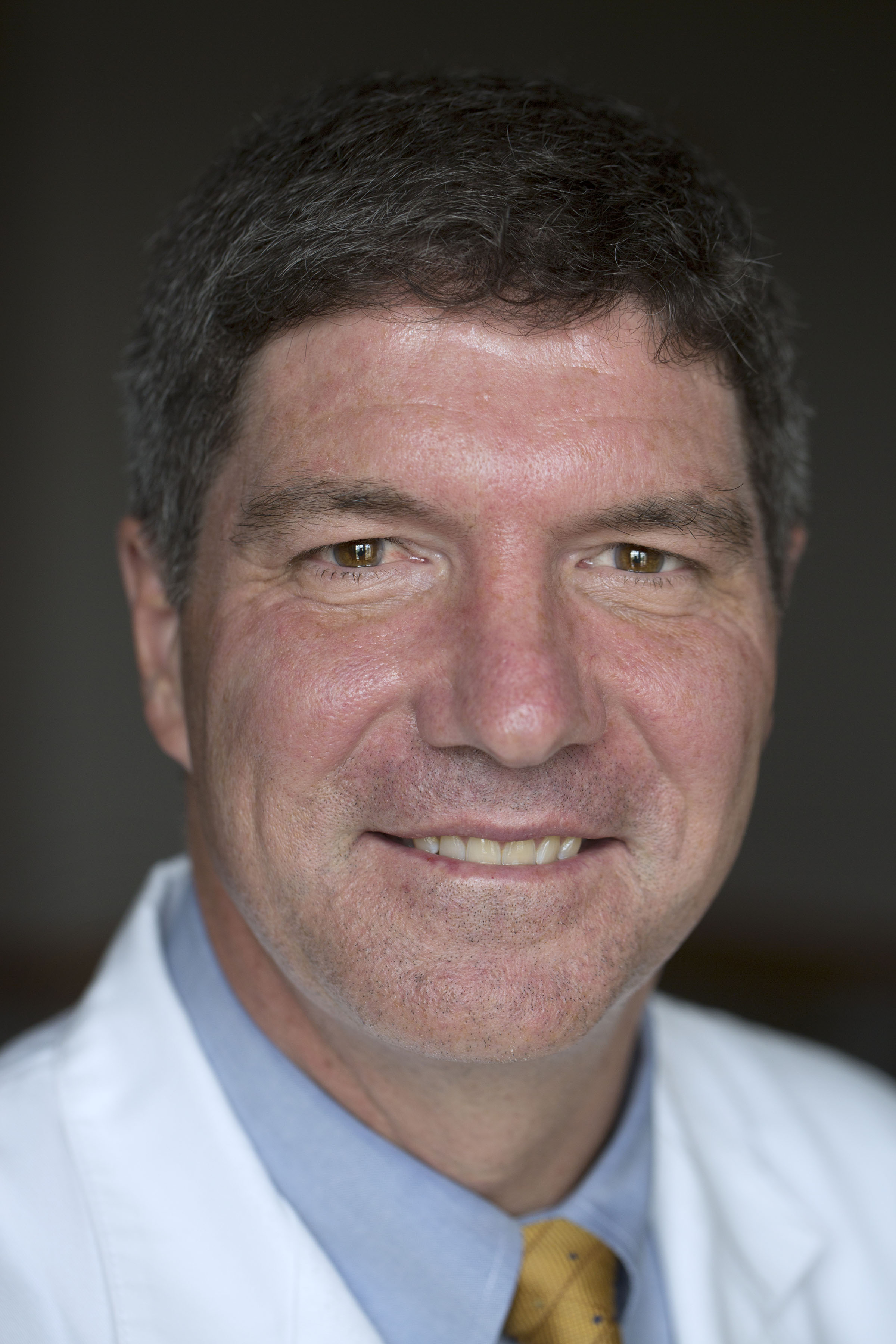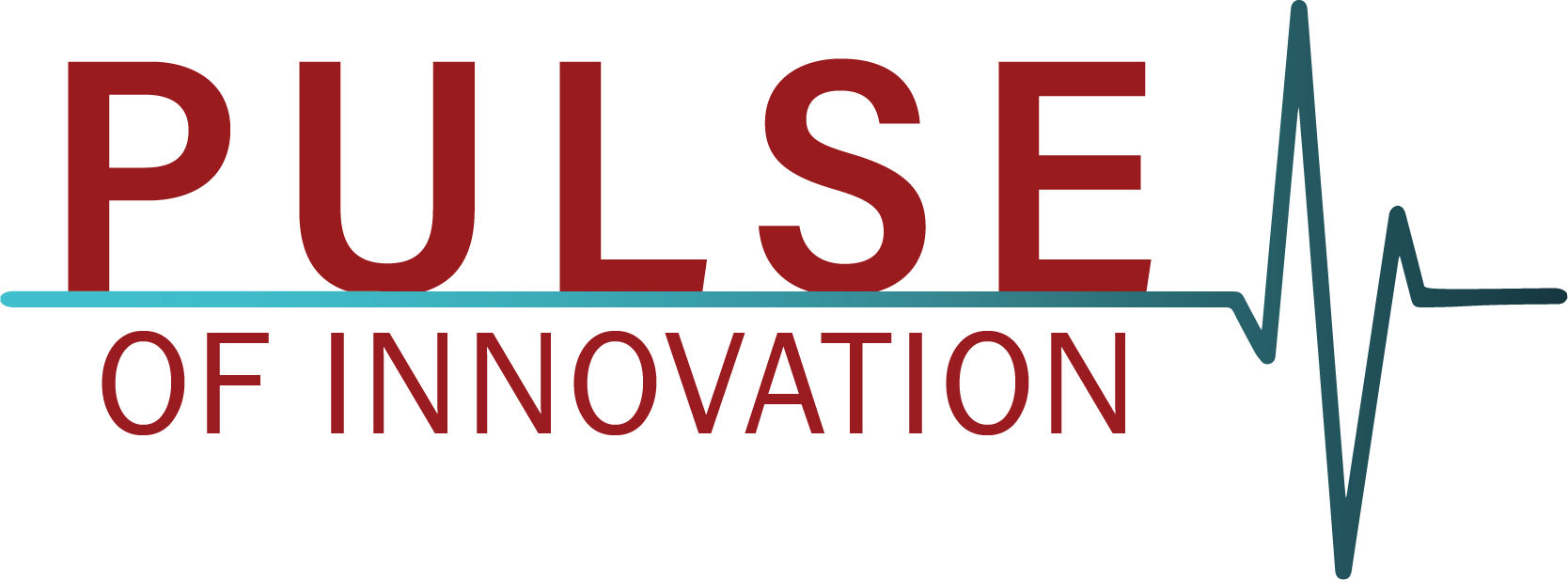

SUPPORTING MTEC THROUGH THE COMBINED FEDERAL CAMPAIGN (CFC)
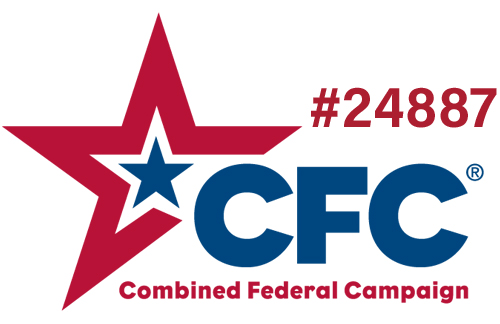
With our drive for innovation within the military and veterans populations, MTEC gained approval as an authorized charity for the Combined Federal Campaign (CFC); the world’s largest annual workplace charitable giving campaign. Your contribution to MTEC through CFC will help us continue our life saving and life changing efforts. Beginning Oct. 2, 2018, you can designate your contribution to CFC #24887. For non-government personnel, your donation through our web portal provides the same funding opportunity to such a wonderful mission.
Your pledge helps us expand collaborative partnerships and speed up the availability of medical solutions for our service members and veterans who sustain traumatic and life-changing injuries while serving our country. For every dollar donated, 92 cents goes directly to research and development of cutting-edge technologies. By combining funds from the military and private sources, we are revolutionizing military medicine through increased numbers of projects and total funding that we are able to award to our members. In 2018, we are striving to award $50 million in funds, and in 2019 we want to do more.
MTEC is excited about the opportunity to raise awareness of its mission to military and federal employees worldwide. Please share our information with friends and family who are eligible to donate to the CFC. Since 1962, military and federal employees have contributed more than $8.2 billion to local, national and international charities through the CFC. Last year alone, there was $101 million contributed.
How you can donate through the CFC:
Pledge process: Pledges will be made through a centralized, national web based giving system
set up by the Office of Personnel Management. Log into the donor pledging site: https://cfcgiving.opm.gov/welcome or contact your local CFC Outreach Coordinator for the complete CFC Charity List.
Volunteer time donations: For the first time this year, employees will be allowed to pledge volunteer time as well as money. Contact MTEC for opportunities by emailing [email protected].
PROJECT AWARD HISTORY: WE ARE GROWING RAPIDLY!
Written by: Kathy Zolman
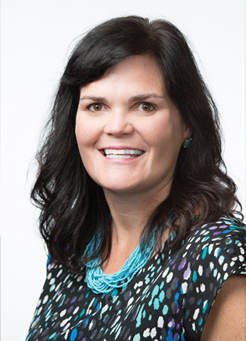
New Award Highlight:
Congratulations to the University of California, San Francisco (UCSF) on the recently funded project entitled, “Transforming Research and Clinical Knowledge in Traumatic Brain Injury Network (TRACK-TBI NET)”. UCSF is bringing to the MTEC an already established and experienced Clinical Consortium that will enable the rapid development and clinical testing of traumatic brain injury (TBI) drug candidates currently in FDA-regulated clinical development. Through this program, the Department of Defense will fund the evaluation of several drug candidates in Phase 2 clinical trials. Federal funding provided by the DoD in support of this program is $25M.
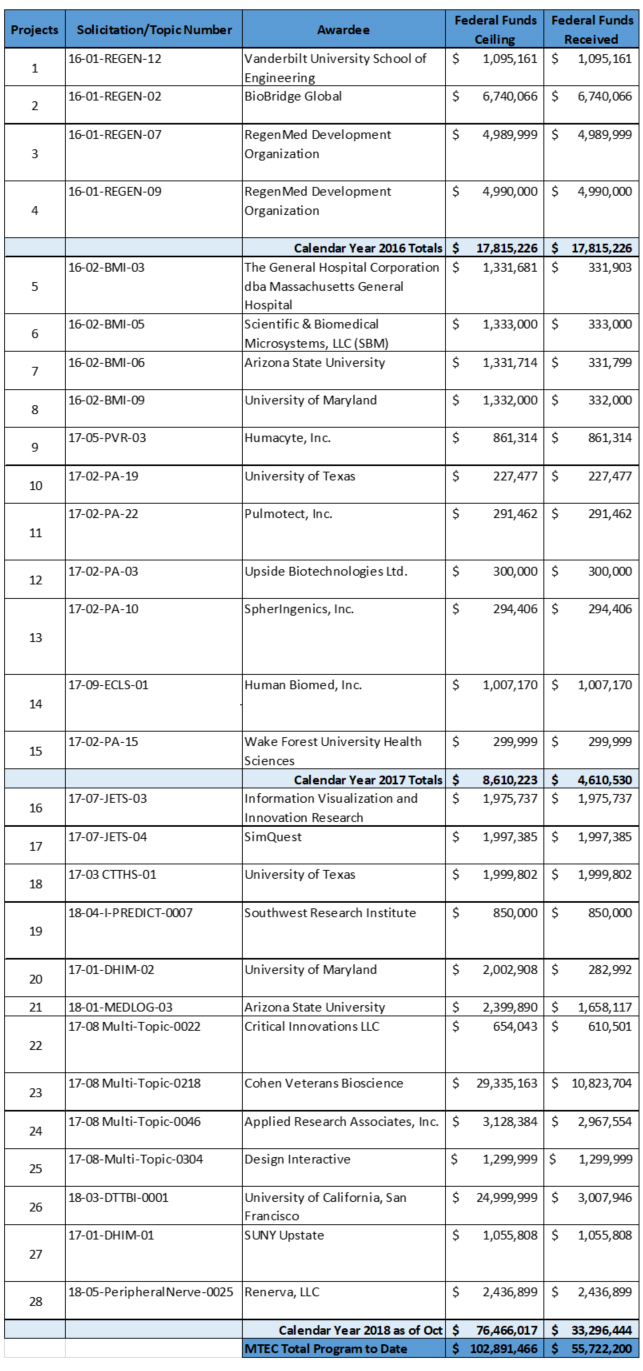
Upcoming Solicitations:
MTEC recently posted three Pre-Announcements, so please refer to the MTEC website’s upcoming solicitations webpage for more information:
- Volumetric Muscle Loss (VML) Repair Following Extremity Trauma
- Burn Patient Transfer System (BPTS)
- Tele-Sleep Decision Assist Tool
Current Opportunities:
MTEC recently posted the MTEC-18-08-Open Concepts Request for Project Information (RPI),
which provides an opportunity for Organizations to demonstrate current capabilities and concept/technologies that may address military medical capability gaps. Organizations are encouraged to submit concepts/technologies under this RPI that they would like the Government to consider when developing the technical research topics to be included in upcoming Requests for Project Proposals (RPPs) expected to be released in fiscal year 2019.
MHSRS DISCUSSIONS: A FEW THINGS TO CLEAR UP!
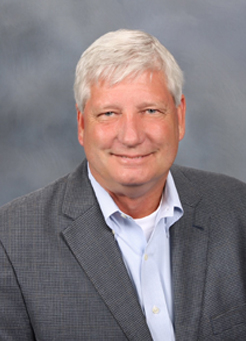
From these discussions, a few new topics were brought to our attention that I would like to address:
1. Solicitation Methods: Please read the solicitations carefully for the intended goal and the methodology being employed. Many potential Offerors jump straight to the technical statement of work and overlook important sections of the solicitation. For example, several people told us they did not know that a Request for Project Information (RPI) did not immediately lead to a potential project award. RPIs are a means to garner information about members’ capabilities and resident technologies and to determine if there is sufficient expertise and technology maturity to bring forth a new topic solicitation. This method is an effective way for potential Offerors to describe new innovations back to the military, so use it wisely.
On the other hand, all Requests for Project Proposals (RPPs) should lead to at least one award (assuming proposals that meet the requirements of the RPP are received). Many MTEC RPPs require several process stages dependent upon the complexity of the topic or the magnitude of funding. Do not confuse the fact that you have been invited to Stage 2 of a solicitation process (such as a preparation of a Solution Brief Pitch or submission of a full proposal) into a belief that you have won the award. The competition does not end until evaluation after the final stage of the solicitation process. The RPP will describe the solicitation methodology used, so please read it carefully. If you have any questions, please contact Dr. Lauren Palestrini or Ms. Kathy Zolman at any time.
2. Discussions during the Proposal Preparation Period: Throughout the RPP process, Offerors may ask questions. This is the most startling improvement of the OTA over standard FAR-based contracting. If you do not understand the requirements, or want to know where the most important aspects of a need lie, or the potential dollar limitations of your proposals, please ask Dr. Lauren Palestrini. She worked with the military to write the technical statement requirements within the solicitation, so she has strong knowledge of their needs and can answer many questions. If she cannot, she will make contact back to the military to obtain answers to your questions. Additionally, MTEC hosts a proposer’s conference (virtual webinar) about 1-2 weeks after the release of each RPP where the military Sponsor describes the technical requirements of the RPP and provides answers to all questions that Offerors have. This is a great opportunity for Offerors to hear directly from the military Sponsor.
3. Proposal Re-Writes: After your white paper, solution brief, or proposal has been evaluated, the military may reach out to you to have discussions. These are opportunities for you to learn from the military and potentially reshape/rewrite your proposal to better reflect the military’s desired goal. Take them seriously for it allows you to provide a better proposal (technically and financially) and eventually a relevant solution from this interchange.
4. Funding Sources: Members feel that it has been difficult to understand funding sources, funding availability, and the many military sponsors (e.g., the Joint Planning Committees, the Program Area Directorates, Army laboratories, different military services). Here are some simple things to remember. At this point in the MTEC evolution, all available funds described in our solicitations are provided by the military, and they have two years to get onto contract and legally up to 5 years to be executed (but you should take far less time than that). MTEC’s own philanthropy fund raising is still too young to contribute dollars to projects, and private dollars from foundations and investor groups will most likely be added outside of the solicitation process and directly to members after negotiation and agreement. The available funds specified within an RPP have normally been there upon award (with a few exceptions).
Where the large disconnect and most likely the misunderstanding lies may be within the Multi-Topic White Papers, for there was the intent to have funds available, but the true dollar value was and remains unset. This was intentional. The intent of this funding mechanism was to first allow funding Sponsors to review the submitted white papers and determine if any were of interest, and second, for funding Sponsors to assess their funding capabilities. So rather than forward planned, it was a reactive funding mechanism where dollars from different “buckets” of money are being pulled together (e.g., expiring FY17 dollars, withheld FY18 dollars, and forward planned FY19 dollars). Although the total process has been lengthier than topic-specific RPPs, proposals will now begin to be placed on award over the next 18 months. The Multi-Topic RPP process was a success in that MTEC will award about $30M now, and is aware of the potential for another $20M next year. In addition, the amount of funding could still increase with time.
5. Teaming: A significant number of MTEC awards are being made to teams, and this is very intentional on our part and often indicated in our RPPs. Our longer-term focus toward the availability of a commercial product to meet a military need often requires that small businesses or universities may have needs that must be filled outside of their own capabilities. We help support this in multiple ways. First, through discussions with potential Offerors, we can connect you with other organizations that may serve as potential team members. Second, after proposals are evaluated, MTEC can combine two (or more) proposal teams to provide a solution more targeted to the military need. In the upcoming months, MTEC will launch a new software application that will allow current members to list their capabilities, which can be searched by other members looking for teaming support. We also plan to conduct webinars that will highlight certain service support capabilities that may be of interest to our membership. We are here to assist you with teaming, but it is ultimately up to you to determine who to team with and whether it is in the best interest of your proposal.
Sincerely,
William Howell
Chief Operating Officer, MTEC
MHSRS 2018
Written by: Patricia Johnson
Year after year, thousands of attendees strategically navigate through the convention side of the Gaylord Resort in Kissimmee, Florida in the hottest month of the year to attend the hottest event of the year for medical innovations—The Military Health System Research Symposium. This year’s theme was “Medical Innovation for Warfighter Readiness: The Future Starts Now.”
Considered the Department of Defense’s premier scientific meeting, it was a remarkable display of current and future innovations and attracted over 2,500 attendees, including military providers with deployment experience, research and academic scientists, and international partners.
There was a steady stream of visitors over the four days of the conference at the well situated MTEC booth. Members came by to get a yellow ribbon to add to their name badge, proudly displaying their MTEC membership.
“We were so encouraged at the response we received at MHSRS,” says Bill Howell, the COO of MTEC who had attendees lining up to meet him and his team at the MTEC booth. “They seemed very interested in hearing about the benefits of membership with MTEC and how better to collaborate.”
Kim Cunningham, MTEC’s Director of Development was also pleased at the number of booth visitors. “We were able to let them know that we were recently approved to participate in the Combined Federal Campaign,” she says. “As a non-profit, donors are very important to us,” she added.
There were rows and rows of booths focused on topic areas like Combat Casualty Care, Military Operational Medicine, Clinical and Rehabilitative Medicine, Medical Simulation and Information Sciences, Military Infectious Diseases. Standing out in the crowd wasn’t an easy task. Walter Reed lured people to their display with one of the hall’s favorite giveaway items, a cell phone charger. Participants were also eager to snag icy or hot Rock Sauce from the RockTape booth to test on their own muscular aches and pains.
“We passed out a coaster with our CFC #24887 on it,” says Cunningham. “It wasn’t the fanciest giveaway but our hope is that every time someone uses it, they see our number and remember to choose us during the CFC campaign that goes through January.”
Participants attended informational sessions throughout the day. For the first time in the history of MHSRS, there was a presentation to discuss how military couples and families are affected by deployments, trauma exposures and PTSD.
LTC Kristal Melvin, US Army Medical BAMC, was glad to secure a spot on the prestigious roster of speakers. She is currently working with a team to develop a grounded theory of post-deployment reintegration for couples and is one of the co-leaders of a research interest group on military families (called FIG for short) sponsored by the TriService Nursing Research Program (TSNRP) a congressionally funded entity, located in Bethesda, MD, on the same base as Uniformed Service University and Walter Reed National Military Medical Center.
MTEC member and CEO of Humacyte, Dr. Jeffrey Lawson presented a Poster Session titled “Engineering Investigational Human Acellular Vessels for Vascular Surgery & Trauma.” In his comments, he thanked MTEC for the role it played in helping him reach his goals. (For more information, see related article on Dr. Lawson on our website.)
It’s not all complex subject matters and heart wrenching stories of battle wounds. Attendees also covet invitations to events where they can socialize and have more in-depth conversations with other like-minded participants.
“We were fortunate to partner with The Conafay Group, and Latham BioPharm Group, this year to host an early evening reception,” says Howell. “The setting was a great respite from the conference area and the attendance exceeded our expectations. MTEC values our relationship with Conafay and Latham BioPharm and especially values the time we get to meet one on one with our members and prospective members.”
MHSRS stands out among all other conferences by hosting researchers with the product developers, including early career investigators, and being the stage where science and military research performs together.
“MTEC considers this conference one of the best opportunities to be in the arena with others who are working to prevent and heal battle wounds,” says Howell. “We definitely will be back.”
AN MTEC MEMBER CALLED INTO ACTION
Written by: Patricia Johnson
Jeffrey Lawson did not know what he wanted to be when he grew up, but he thought it would be related to biology or the life sciences because he loved his biology teachers. He mulled over the thought of being a naturalist. He was intrigued by how the world works, how nature and science interact, and he liked people.
What he did know early on was that he wanted to have the traits of Hawkeye Pierce on M*A*S*H, the Army surgeon who demonstrated empathy, compassion, a sense of humor, and the courage to buck the system when life and death was on the line.
Lawson dedicated his PhD thesis to his biology teachers who he credits for his insatiable curiosity and desire for discovery but didn’t stop his education there. He became an MD and fully tenured professor at Duke University Hospital, as well as a vascular surgeon and a pioneer in the field of bioengineered blood vessels. He co-founded Humacyte along with Dr. Laura Niklason and now serves as its President and Chief Executive Officer. Humacyte is an innovator in biotechnology and regenerative medicine.
He is fulfilled by his work as a pioneer, one of the first on a team to grow human blood vessels. “I am a physician who likes people, and I am curious how it all works,” admits Lawson. “Surgery informs how I can make it better in the future,” he explains… Read more.
MTEC BOARD NOMINATION PERIOD OPEN NOW
Nominations for the MTEC Board of Directors are being accepted from the membership for the Academia/Not for Profit seat through November 1st, 2017. Please complete a Director of Nomination Form (includes Nomination Policy & Election Procedure) and submit to: Stacey Lindbergh, MTEC Executive Director at [email protected].
The Nomination Committee will compile the nominations received and develop a slate of no more than 5 nominees. The MTEC Board of Directors will vote on the nominees at the annual MTEC Board meeting in January 2019. In accordance with the MTEC Bylaws, the elected member’s three-year term will commence immediately. Board members are permitted to serve two terms.
SAVE THE DATE: MARCH 19-21, 2019
4th Annual Membership Meeting
MTEC is pleased to announce the 4th Annual MTEC Membership meeting which will be held at the University of California – San Francisco Mission Bay Conference Center.
What: 4th Annual MTEC Membership Meeting
When: March 20 & 21st MTEC – plus an Optional Pre-meeting event featuring Venture Capital Representatives on March 19, 2019
Where: Mission Bay Conference Center at UCSF, San Francisco, California
The meeting will provide a forum for gaining insight into near-term R&D requirements, promoting idea exchange and enhancing networking opportunities. In addition, an optional pre-meeting event will provide members the opportunity to meet and present to Venture Capital firms and investors. Invited attendees will include MTEC members, industry thought leaders, government research sponsors, philanthropic leaders, and venture capitalist. Non-members are welcome to attend portions of the event.
Information regarding the agenda, hotel blocks, side field trips, and networking events will be forthcoming.
Mark your calendar, and join the leading biomedical research & development community!

